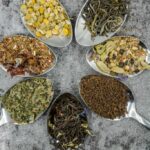Having just returned from the wild and magical land of Southern France (The Plan d’Aups area, the coastal region of the Carmargue and the Aude area at the foot of the French Pyrenees), I was full to bursting with inspiration to research some of the plants I came to know there. One of the main aspects of travelling I adore is to come face to face with new plants, ones I may have seen in the pages of books or read about in some old obscure Herbal but never had the pleasure of meeting in the flesh.
This pilgrimmage in the footsteps of Mary Magdalene and the path of the Divine Feminine did not dissapoint! On arrival at the beautiful Hostellerie de la St Baume, a monastery run by Dominican Brothers, I was immediately struck by the profusion of lush green May foliage and flowers. There were some very familiar faces such as Red Clover, Ribwort Plantain, Poppies and the like but one leapt out as really interesting, enough to stop the car and investigate. The plant that caught my attention had a cluster of upright green sword like leaves coming from a rosette at the ground with a large tall flower spike that was covered in round green seed pods. With no flowers around to look at, it would be hard to find its name without a sense of the flower. I took some photos of the leaves and seed pods and jumped back in the car.
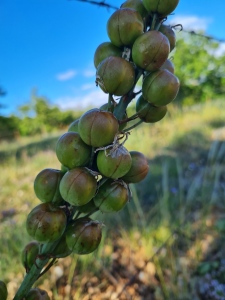
White Asphodel seed pods
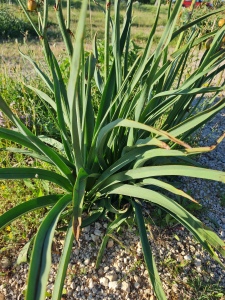
Lily like leaves of White Asphodel
Not much to go on at that point. A couple of hours later we were eating our picnic dinner on the glorious fields outside the hostellerie, excited to be at the foot of the mountain that holds the sacred mountainside cave chapel, dedicated to Mary Magdalene and the way of the heart, knowing we would climb it the next morning. Bathing in the last warm rays of the sun and the sheer magic of the place, I spotted the same large stalks covered in the round green seed pods growing just a few feet away. As I walked towards the clump I realised there were plenty of plants with white star like flowers still blooming, right at the top of the stalk. A few days later and they might all be seed pods, I felt blessed to be able to sit with the flowers and immerse myself in their environment. The ground on this high plateau is rocky, thin, well drained and very hot in the summer yet cold and snow covered in the winter. Many photos were taken so I could get a really good sense of the plant. A few days later I started looking in earnest for its name and eventually it was revealed – it was White Asphodel, Asphodelus Albus to give it its Latin name. When I encounter a new plant that has ‘called’ to me and then eventually learn its name, my heart sings out with sheer joy. This particular plant felt significant on first sight but only after reading about its history and the mythologies surrounding it did I realise why.
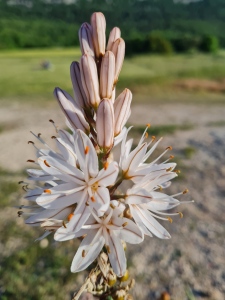
White Asphodel Flowers
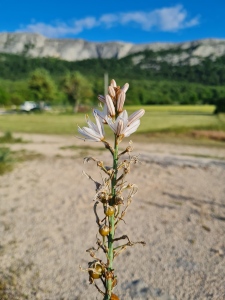
White Asphodel at St Baume
The White Asphodel has long been associated with Death and the Afterlife, linked with both Persephone and Hecate. According to the ancient Greek mythologies, it grows in profusion in the vast eternal fields of the Underworld, where spirits that were neither particularly good or bad in life, rest after drinking the waters of forgetfullness. The fields lie bewtween Elysium – a place reserved for the great heroic souls favoured by the Gods – and Tartarus where the wicked and evil-doers reside. It is often described as a vast and never ending plain of Asphodels, a place of boredom and sober monotony for ordinary souls who achieved neither glorious fame nor notoriety, a melancholic place where ordinary souls wander aimlessly with no purpose, eternally.
Yet having experienced the joy I felt in the presence of these flowers growing wild in their mountain meadows, it seems to me to have a much more profound meaning. Their exquisite white flowering spires were, for me, a shining torch light that serves as a guide when we are at the threshold of something new or unknown. Like Hecate, who stands at the crossroads of all thresholds and transitions, she guards and guides us mortals when we need it the most, if we ask of course. Persephone was thought to have been distracted by the sheer beauty of the Asphodel flower when Hades abducted her into the Underworld, besotted by her beauty and innocence. It was Hecate, amongst others, who journeyed down to try to bargain for her release, the compromise being that Persephone would spend half of the year in the Upper world (Spring and Summer) as Goddess of vegetation and fertility and half the year in the Underworld (Autumn and Winter) as Queen of the Underworld and protector of the dead.
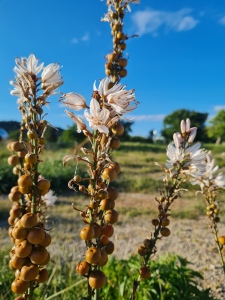
White Asphodel (Asphodelus albus)
Everything about this plant therefore speaks to balance and the safe passage across thresholds and transitions, both seen and unseen. Yet unlike the vast ghostly fields of the Greek Underworld, my own personal fields of Asphodel feel calm, resolute, pregnant and vibrating with creative powers. Endless yes, but endlessly forgiving and understanding and forever in awe of the beauty of Nature. It is an inner place I feel called to strongly – to walk the delicate line between left & right, this & that, without judgement – to just be. To be at peace between order & chaos, youth & old age, life & death, joy & despair, wild woman & homely domestic mother, dogma & freedom, masculine & feminine, sacred & profane. Like Persephone, whose misfortune at being ripped from her happy place amongst the Spring flowers and hurled into the Underworld of lifelessness, may we all find our place of balance and reign supreme within the light and the dark !
On a more Eartly note, White Asphodel has a good few medicinal and nutritional qaulities too, historically and even today being used as a food source, the roots being dried then boiled in water or roasted in a fire (to remove harmful constituents) and mixed in with other flours or starchy plants to use in baking or animal food.
The root has medicinal actions that include anti-inflammatory, diuretic, anti-oxidant, anti-bacterial, anti-cancer (particularly melanomas), as well as the roots being used externally as an excellent skin remedy for acne and other skin conditions, as a mouthwash for maintaining good oral health (candida etc) and to bring on absent or delayed menstruation.
Not surprisingly given its associations, it has been considered to be the favourite food of the dead in its native lands and was often planted around graves and tombs.
